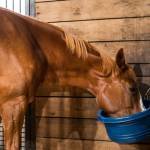Small, Frequent Meals Increase Nutrient Digestibility in Horses

Feeding horses a limited number of meals each day can lead to health problems, including increased incidence of gastric ulcers and hindgut acidosis. Recent research revealed another concern related to meal feeding: decreased nutrient digestibility.
In a pasture setting, horses graze intermittently, consuming small amounts of high-fiber, low-starch feed at a time, many times a day. Because their stomachs are small relative to their body size, horses thrive on this routine of multiple meals a day. When fed large meals, the stomach cannot “hold” the meal, leading to ingesta passing through the stomach without being appropriately prepared for later digestion and fermentation in the small and large intestine. Horses miss out on essential nutrients when this occurs.
“Splitting large amounts of concentrate feed into several smaller meals will reduce meal size and maximize feed efficiency and utilization. This is particularly important for horses that need to gain weight,” said Catherine Whitehouse, M.S., a Kentucky Equine Research nutrition advisor. “Owners spend a lot of time and consideration selecting the best feed for horses only to have management practices limit its nutritional value.”
Improved nutrient digestibility achieved by feeding horses smaller, more frequent meals was demonstrated in recent research.* In that study, horses were divided into four groups and fed either two, four, six, or eight times a day, spread out equally over the 24-hour period. All horses were fed the same amount of calories over the course of each day, and diets were 30% concentrate feed and 70% hay. Horses acclimated to their feeding schedules for 21 days before researchers collected blood samples for metabolic analyses and measurement of nutrient digestibility using an internal marker technique.
“Measures of nutrient digestibility increased in a steady linear fashion with an increased number of meals,” explained Whitehouse.
Researchers theorized digestibility increased because of the decreased passage rate of the digesta through the gastrointestinal tract. With slower transit times, digesta is exposed to digestive enzymes and microbial fermentation for longer periods.
In addition, blood glucose concentrations were significantly decreased as feeding frequency increased. In all horses, regardless of the number of meals, blood sugar levels remained within the normal range; however, fluctuations in blood sugar levels were far less pronounced when horses consumed smaller, more frequent meals.
“Offering more than four equally spaced meals to horses per day is likely unrealistic for many owners. But there are automatic feeders available that can be used to deliver concentrate feed or hay pellets,” advised Whitehouse.
Owners should appreciate that the researchers offered the hay in several meals, as they did with the concentrates according to Whitehouse. “Sometimes we focus on the concentrate meal size, but the quality and amount of forage being offered are also important considerations.”
Even if small, frequent meals are fed, horses with a high plane of nutrition that require calorie-dense feedstuffs can still benefit from high-quality digestive supplements. Look for supplements that support total digestive tract health, including gastric and hindgut well-being.
*Direkvandi, E., Y. Rouzbehan, and H. Fazaeli. 2021. The positive impact of increasing feeding frequency on feed intake, nutrient digestibility, and blood metabolites of Turkmen horses. Journal of Equine Veterinary Science 98:103390.








